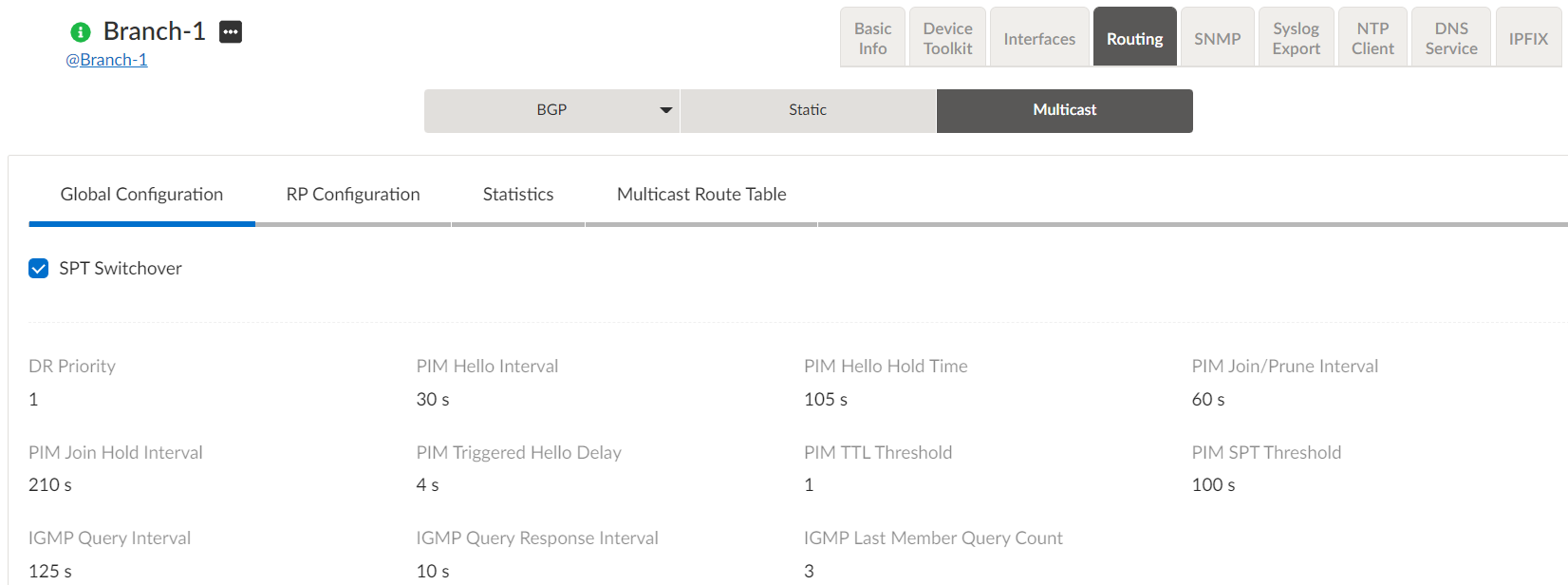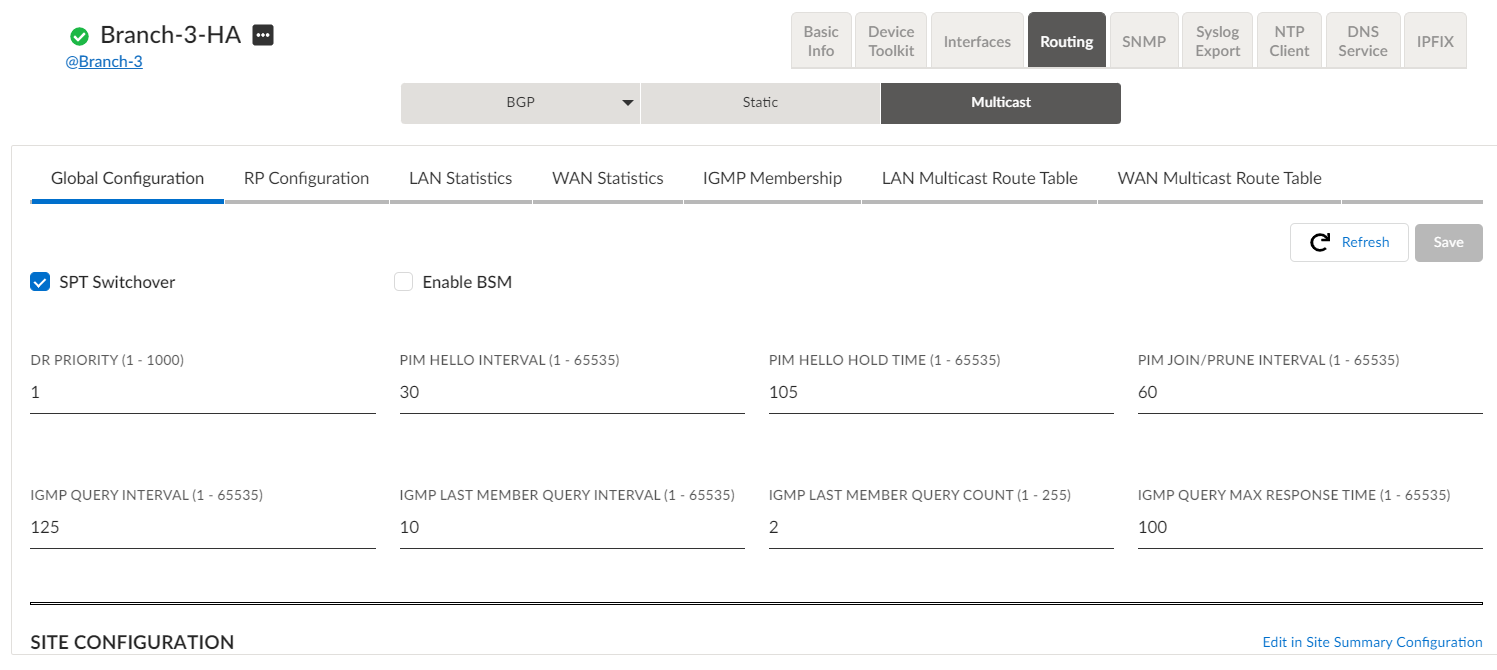Prisma SD-WAN
Configure Global Multicast Parameters
Table of Contents
Expand All
|
Collapse All
Prisma SD-WAN Docs
-
-
-
- CloudBlade Integrations
- CloudBlades Integration with Prisma Access
-
-
-
-
- 5.6
- 6.1
- 6.2
- 6.3
- 6.4
- 6.5
- New Features Guide
- On-Premises Controller
- Prisma SD-WAN CloudBlades
- Prisma Access CloudBlade Cloud Managed
- Prisma Access CloudBlade Panorama Managed
Configure Global Multicast Parameters
Configure global multicast parameters after you enable multicast for a Layer 3 LAN
interface on a branch ION device or a WAN interface on a data center ION device in Prisma
SD-WAN.
| Where Can I Use This? | What Do I Need? |
|---|---|
|
|
Configure global multicast parameters after
you enable multicast for a Layer 3 LAN interface on a branch ION
device or a WAN interface on a data center ION device.
- Configure global multicast parameters for a branch ION device.Configure global multicast parameters on your branch ION device after you enable multicast for a Layer 3 LAN interface on a branch ION device.
- Select WorkflowsDevicesClaimed DevicesConfigure the deviceRoutingMulticastGlobal Configuration.You can view the Multicast tab only after you enable multicast for a Layer 3 LAN interface.Select SPT Switchover to enable Shortest Path Tree (SPT) switchover.SPT Switchover is enabled by default. This indicates that once the first multicast packet is received, that is, when the receiver receives the source address, the Designated Router (DR) at the receiver’s end and the Rendezvous Point (RP) choose the optimal path to relay information from the source to the receiver.It is a good practice to always enable SPT.You can edit the global multicast parameters only for devices running software versions 6.0.1 or later.ION devices running software versions lower than 6.0.1
![]() ION devices running software versions 6.0.1 or higher
ION devices running software versions 6.0.1 or higher![]() The descriptions for the global multicast parameters are based on the PIM-SM specification outlined in RFC 4601 (https://datatracker.ietf.org/doc/html/rfc4601).The multicast parameters are read-only for devices running versions lower than 6.0.1.
The descriptions for the global multicast parameters are based on the PIM-SM specification outlined in RFC 4601 (https://datatracker.ietf.org/doc/html/rfc4601).The multicast parameters are read-only for devices running versions lower than 6.0.1.Field Description Default Value SPT Switchover Select to enable shortest path tree (SPT) switchover. This indicates that once the first multicast packet is received i.e. the source address is received by the receiver, the DR at the receiver’s end and the RP choose the optimal path to relay information from the source to the receiver. Enabled Enable BSM Select to enable receiving and forwarding of BSM on multicast enabled interfaces. BSM is a protocol by which the device learns RPs dynamically.Available only for ION devices running software versions 6.0.1 or later. DR Priority Indicates the probability of a PIM interface being elected as a Designated Router (DR). For Static RP, the DR Priority advertised in a PIM Hello is 1. 1 PIM Hello Interval Indicates the time interval between two PIM Hello packets. 30 s PIM Hello Hold Time Indicates the time interval for which a neighbor should wait for a Hello message from a sender neighbor before pruning the neighbor. 105 s PIM Join/Prune Interval Indicates the time interval between two Join/Prune messages sent to a neighbor. 60 s PIM Join/Hold Interval Indicates the time interval for which a receiver should wait for the next Join/Prune message from the neighbor before pruning the neighbor. 210 s PIM Triggered Hello Delay Indicates the value of the Hello timer for delay between triggered Hello messages. Available only for ION devices running software versions earlier than 6.0.1. 4 s PIM TTL Threshold Packets with a lower TTL than the PIM TTL Threshold are discarded. Available only for ION devices running software versions earlier than 6.0.1. 1 PIM SPT Threshold Indicates the cut-over time from Rendezvous Point Tree (RPT) to SPT. Available only for ION devices running software versions earlier than 6.0.1. 100 s IGMP Query Interval Indicates the time interval between successive IGMP queries. 125 s IGMP Query Response Interval Indicates the maximum response time advertised in the IGMP query. 10 s IGMP Last Member Query Count Indicates the number of times the ION device sent IGMP queries to the last known active host on the subnet. 3 IGMP Last Member Query Response Interval Indicates the time interval for the ION device to respond to the IGMP query from the last known active host on the subnet. 1 s IGMP Querier Timeout Indicates the timeout interval to wait before becoming a Querier. Available only for ION devices running software versions earlier than 6.0.1. 380 s IGMP Query Max Response Time Indicates the maximum response time to the IGMP query. Available only for ION devices running software versions 6.0.1 or later. 100 s Multicast Site Profile Displays the multicast site profile associated with the branch site.(Optional) Click Edit in Site Summary Configuration to change the associated multicast site profile. Configure global multicast parameters for a data center ION device.Configure global multicast parameters on your data center ION device after you enable multicast for a WAN interface on a data center ION device. You can configure multicast for data center ION devices running softwares versions 6.0.1 or later only.- Select WorkflowsDevicesClaimed DevicesConfigure the deviceRoutingMulticastGlobal Configuration.
![]()
Field Description Default Value SPT Switchover Select to enable shortest path tree (SPT) switchover. This indicates that once the first multicast packet is received i.e. the source address is received by the receiver, the DR at the receiver’s end and the RP choose the optimal path to relay information from the source to the receiver. Enabled Enable BSM Select to enable receiving and forwarding of BSM on multicast enabled interfaces. BSM is a protocol by which the device learns RPs dynamically. DR Priority Indicates the probability of a PIM interface being elected as a Designated Router (DR). For Static RP, the DR Priority advertised in a PIM Hello is 1. 1 PIM Hello Interval Indicates the time interval between two PIM Hello packets. 30 s PIM Hello Hold Time Indicates the time interval for which a neighbor should wait for a Hello message from a sender neighbor before pruning the neighbor. 105 s PIM Join/Prune Interval Indicates the time interval between two Join/Prune messages sent to a neighbor. 60 s WAN multicast peer group profiles Displays the multicast site profiles created with the data center site as the multicast source. (Optional) Click View in Site Summary Configuration to change the associated multicast site profile.



